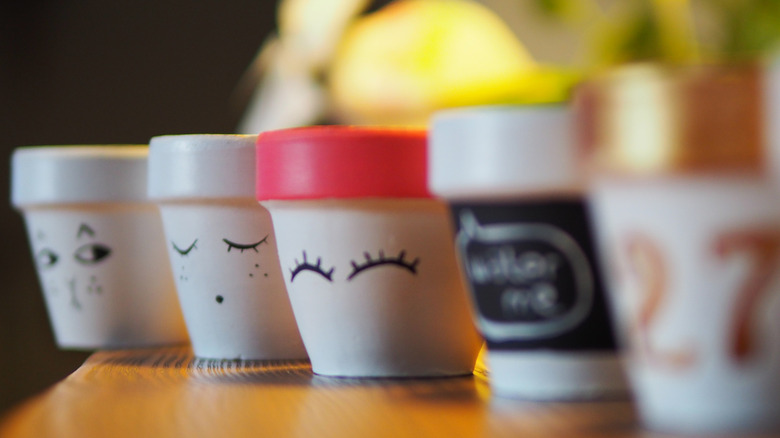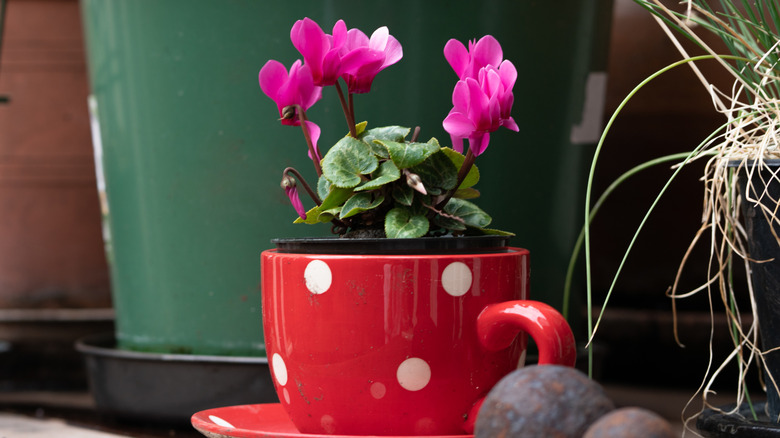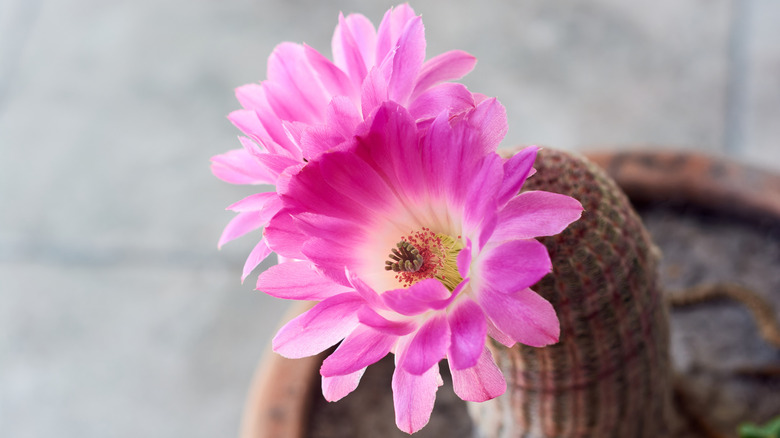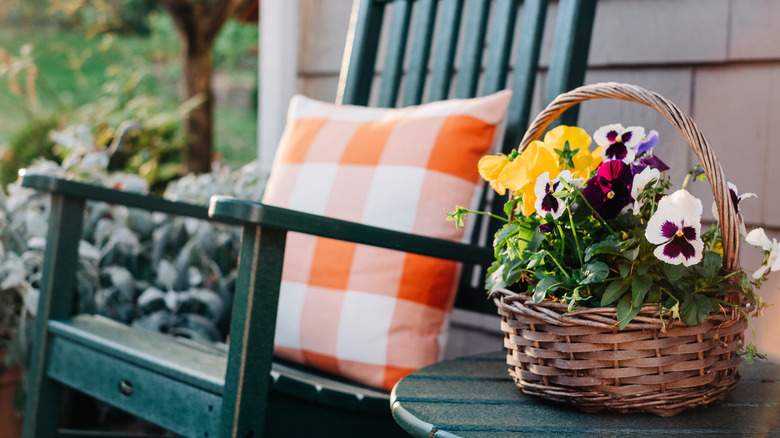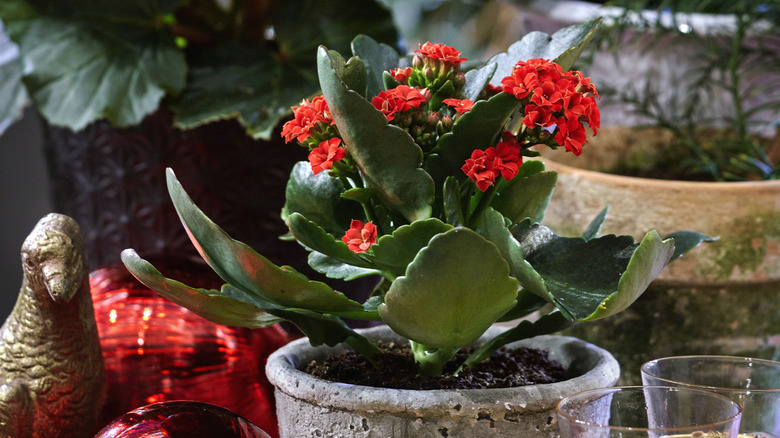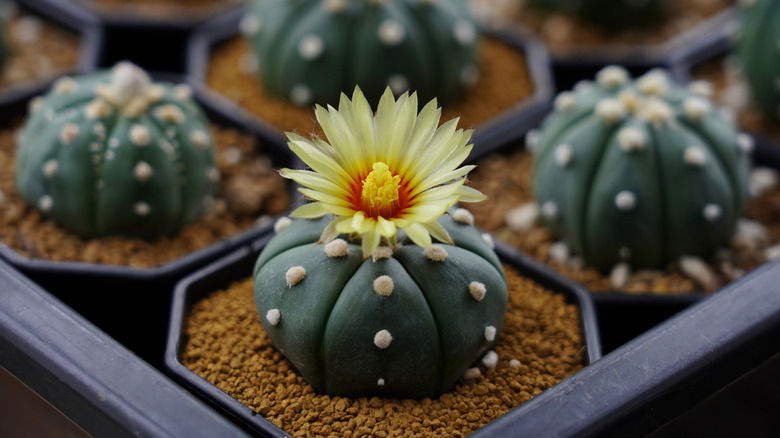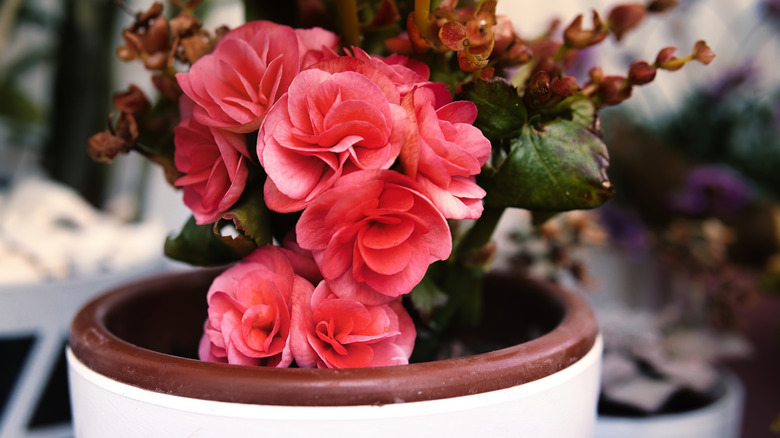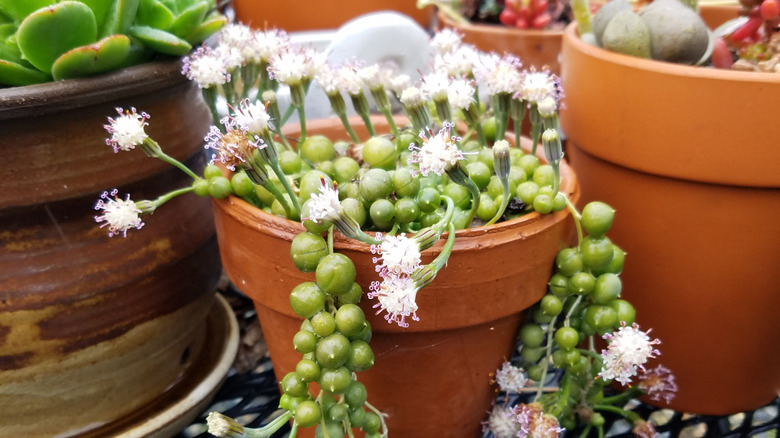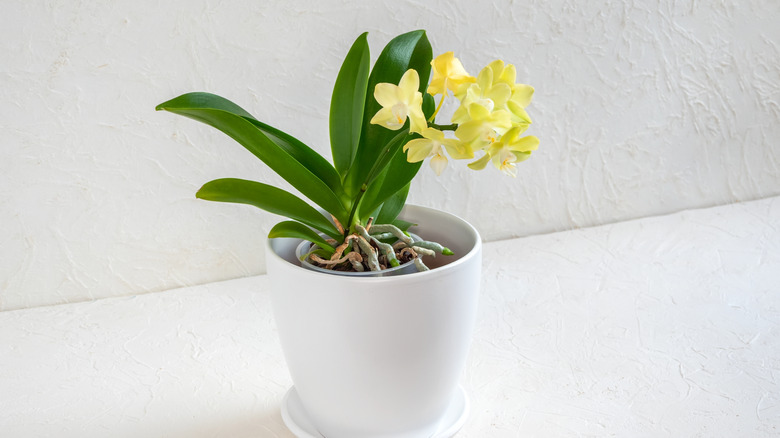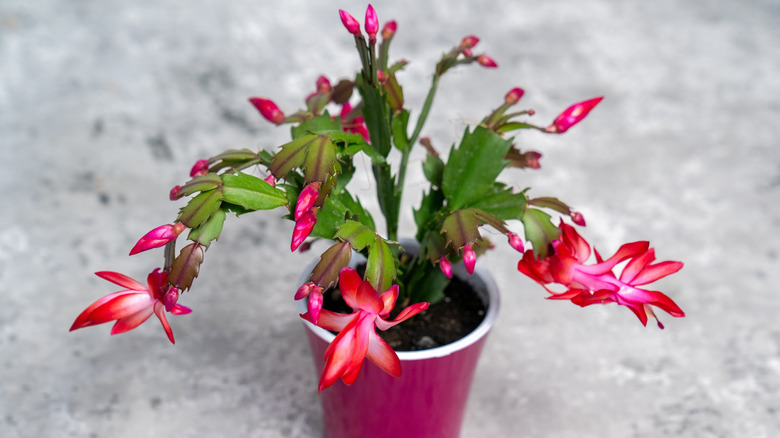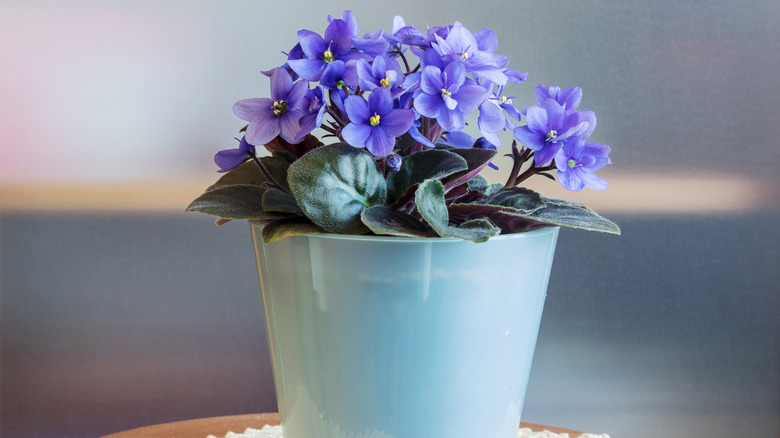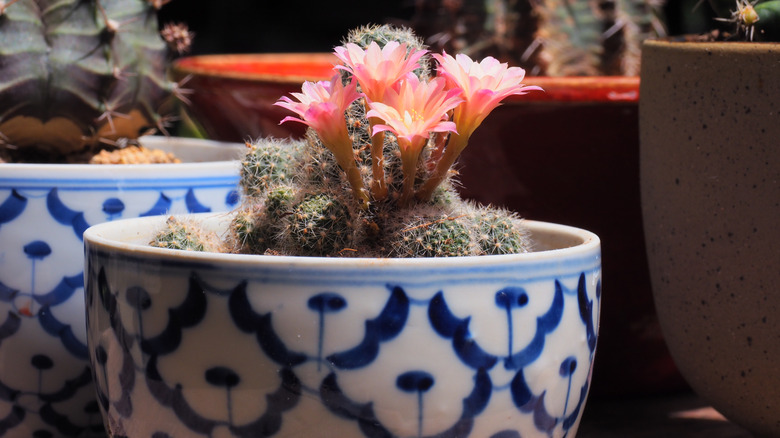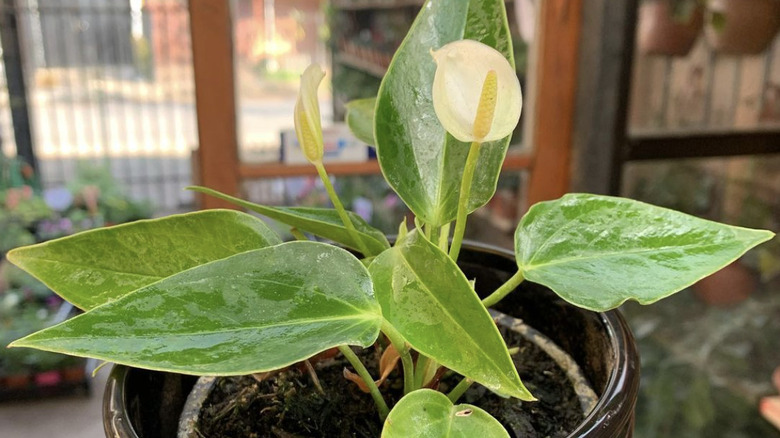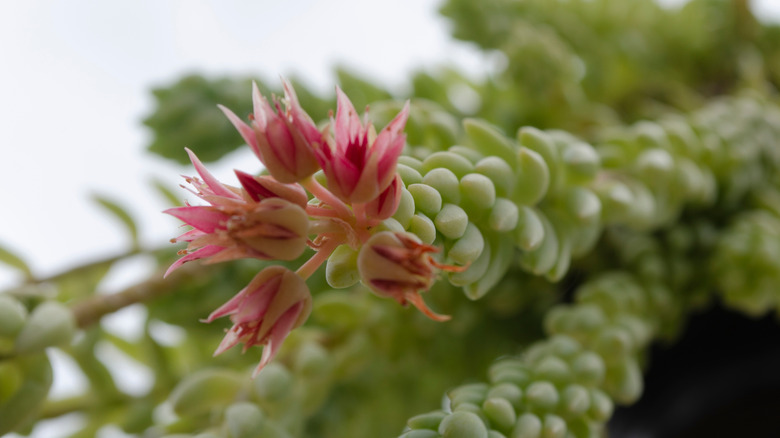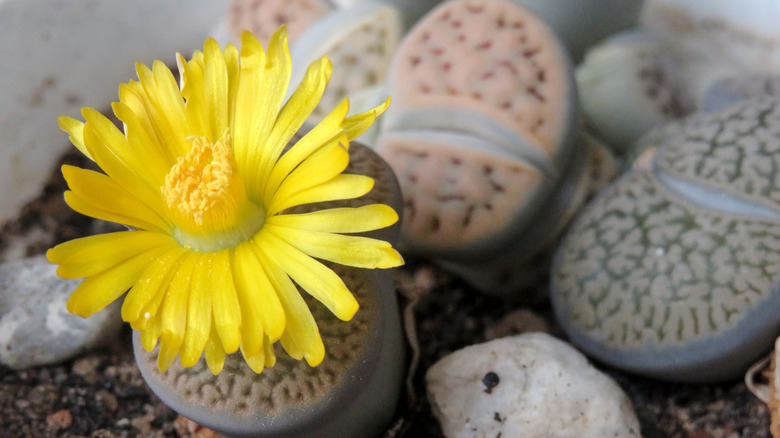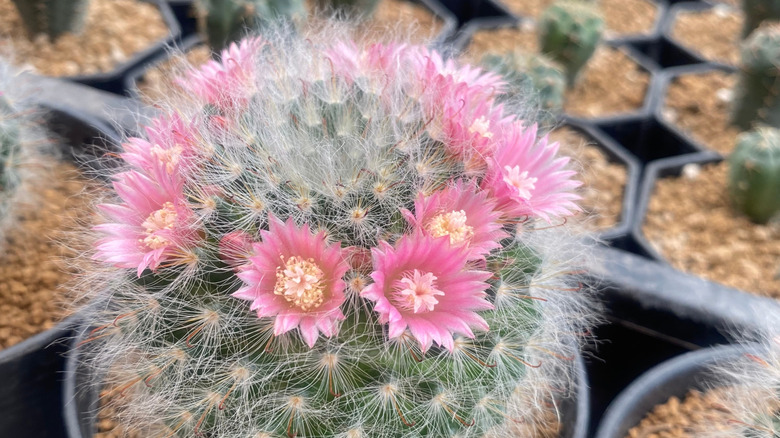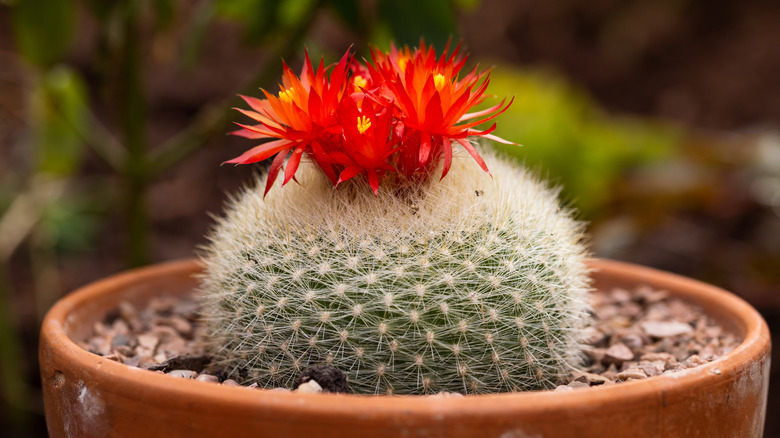16 Of The Best Flowers To Grow In Mini Plant Pots For A Whimsical Garden
When space is at a premium, indoors or in your yard, container gardening is a great way to experiment with growing lots of different plants that you can move around to get the growing conditions just right. If they're small plants, that makes it even easier. Some container gardeners start out with windowsill herbs, but there's no reason you can't experiment with flowering plants as well. It's even possible to grow some of your favorite flowering houseplants in smaller varieties. Does that include kalanchoes, anthuriums, and African violets? You bet!
If you want to grow a whimsical container garden that is also a breeze to maintain, we have more cacti and succulents for you to explore, too. And don't worry. They bloom! Here, you'll find specific ideas for an array of small blooming plants as a point of departure. We have 16 you can consider, many of which are super easy to grow.
Cyclamen
If you're looking for a winter-blooming plant, this little beauty can deliver in hues ranging from red to pink and light purple. Cyclamen (Cyclamen persicum) comes in various sizes, including miniatures that can be grown in small containers. Consider watering it from the bottom since too much moisture directly on the plant can cause it to rot. Placing your cyclamen in an area away from direct sunlight and excessive heat will keep it looking its best. They also like fertilizer with low nitrogen content every month or two while they're blooming. Remember, however, that cyclamen is one of the houseplants you should never grow in a home with pets.
Rainbow cactus
Rainbow cactus (Echinocereus rigidissimus) is a small cylinder-shaped perennial succulent that grows from 2 to 4 inches across — a perfect fit for a small pot. Since they top out at about 6 inches tall, they can add some height to a grouping of small container plants, too. The vibrant pink or purplish red blooms on these little beauties grow large in comparison to the size of their host. When not blooming, this cactus keeps it interesting, with closely spaced spines in pink, red, yellow, and white hues growing in unique rings that give them the rainbow part of their name.
Pansies
There are several things you need to know before planting pansies (Viola x wittrockiana), including that these are cool weather show-offs that are easy to grow. When at their blooming best, their colorful flowers range from about 1 inch to 3 inches in size, so the more petite varieties look right at home in a small container. Plan on snipping away spent blooms to encourage new ones when caring for your pansies. Feeding them with slow-release fertilizer every three weeks or so is also a good practice when growing them in pots, too.
Kalanchoe
Kalanchoe (Kalanchoe blossfeldiana) is another plant that blooms during the winter, and they come in varied sizes, including miniatures. Most end up as indoor container plants since kalanchoes are only hardy outdoors in zones 10 and 11. Luckily for growers of these succulents, taking care of kalanchoe plants is pretty straightforward. They like moderate light (not too much direct sunlight) and do best when they dry out between waterings. When they're happy, they'll sometimes sprout new plants that can be repotted. Red is a popular kalanchoe color, but they come in yellow, pink, and orange varieties, as well.
Star cactus
You may know star cactus (Astrophytum asterias) as sea urchin cactus or sand dollar cactus. These little beauties are often sold when they're just 2 inches or so wide, so they can make excellent plants for mini pots. The flowers they produce are a lovely yellow color with orange centers, and they're sometimes larger than the cactus. One important thing to note about these is that they are endangered in the wild where they grow in Texas; be sure to buy them from reputable growers and never dig them up on your own.
Begonia
Mention the Begoniaceae family of plants, and many people think of wax begonia (Begonia semperflorens-cultorum) varieties that are filled with blooms in garden centers every spring and summer. Still, several variations of wax begonias with clusters of red, pink, or white flowers can be grown in small containers. They like drying out before they're watered again and being placed in bright spots with indirect light for growing indoors. Keep dead or yellow leaves pinched or clipped off and remove spent blooms to make this plant look its best.
String of Pearls
Maybe you've seen string of pearls (Senecio rowleyanus) plants before, but did you know that they will bloom for you? Successfully growing a string of pearls plant in a small container is certainly doable, too. These vining succulents look pretty trailing from small pots but are particularly popular as hanging plants. Those don't have to be large either; make one from a small coconut shell for a unique boho vibe. Look for blooms to form on this plant in the summertime. As a bonus, the scent the flowers emit is described as being similar to cinnamon.
Orchids
Moth orchids (Phalaenopsis), also known as moon orchids, come in lots of different sizes, including miniatures. With some nurturing, they can make beautiful flowering houseplants that come in several different colors. You may have to move them around to find the perfect blend of a brightly lit location out of direct sunlight and a temperature between 59 and 77 degrees Fahrenheit, preferably in a humid area. Avoid overwatering by soaking your mini orchid for 15 minutes when the roots turn white or gray and allowing the plant to completely drain before placing it back in its perfect growing spot.
Christmas cactus
If you like your small plants on the exotic side, don't forget about the Christmas cactus (Schlumbergera bridgesii). Native to tropical climates, these plants require more water than cacti hailing from desert environments. The Christmas cactus likes a thorough soak when it dries out, but don't leave it sitting in water. When flower buds start to appear in the fall, increasing the watering frequency will encourage them to open sooner. Expect long-lasting blooms for a month to six weeks. Keep it looking good by pruning stems after they bloom while keeping the plant's symmetry in mind.
African Violets
African violets (Saintpaulia ionantha) are known for their beautiful purple blooms, but did you know they come in mini versions with pink, fuchsia, and white blooms, too? They grow their best when kept at about 60 degrees Fahrenheit at night and no higher than 85 degrees Fahrenheit in the daytime. Keeping the leaves dry is also imperative, as drops of water can cause discoloration; bottom watering can easily solve this problem. Your African violet may require some pampering, but once you get all the conditions right, you can count on it to bloom virtually nonstop.
'Carnival' crown cactus
'Carnival' crown cactus (Rebutia 'Carnival') is one of many from the blooming family of rebutias. Even at its largest, this little sun-loving cactus measures about 2 to 3 inches tall and 2 to 4 inches across, making it a perfect addition to a collection of petite container plants. These hybrids are known for putting on clusters of pretty pink blooms. Like other rebutias, they can be grown in all types of pots as long as they have adequate drainage. If your home doesn't have lots of sunlight streaming in, you can try using high-intensity lighting to keep them healthy and happy.
Anthurium
Anthurium (Anthurium andraeanum), with its heart-shaped blooms, makes a popular houseplant in many homes, but did you know they come in mini versions, too? The little varieties come in a variety of cultivars, including those with white, purple, orange, or pink blooms that measure just 1 to 3 inches wide. Regardless of the color, they like their soil to remain moist, and they thrive on humidity, so if you're looking for a small plant for your bathroom, this could be the one — providing you have adequate light. They grow best in spots with lots of indirect sunlight.
Burro's tail
While you might think of burro's tail (sedum morganianum) as growing in an amazingly large hanging basket, it doesn't necessarily have to. This sweet little member of the stonecrop family can be purchased in 2 to 4-inch pots. And since they're slow growers, they're perfect for tucking into petite containers. When they flower in the mid-spring and fall, these succulents put on blooms that vary in color from pink to red. In addition to bright natural light, burro's tail responds well to grow lights, so that's something to keep in mind if you plan to bring your indoors.
Living stones
If you're into oddities, consider adding living stones (Lithops) aka 'butt plants' to your small container garden. Their name is appropriate since they really do look like 1 to 3-inch wide rocks until they start to bloom. Then, they put on sunny yellow flowers from around the middle of fall to the beginning of winter. They grow slowly and only require light watering once every couple of weeks; they won't thrive if given too much moisture. A spot where they can get a good amount of sun in the morning and partial shade in the afternoon is perfect for indoor growing.
Powder puff cactus
The powder puff cactus (Mammillaria bocasana), sometimes called powder puff pincushion, lives up to its name, with its downy spines giving it a poofy appearance. Among the fluff, numerous flowers pop up from spring to early in the fall in hues ranging from pink to yellow and cream. Those blooms are small, measuring under 1 inch, but they're usually abundant. Considered a miniature cactus at 2 to 3 inches wide, it's great for growing in a little container. It will clump as it grows, though, so you may have to repot your powder puff cactus over time.
Scarlet ball cactus
When it comes to descriptive monikers, scarlet ball cactus (Parodia haselbergii) lives up to its name. This small, round plant is very obviously a cactus with a proliferation of spiky thorns covering its entire surface, giving it an almost fuzzy appearance. The pretty blooms it puts on toward the end of wintertime are bright red to orange with yellow centers. Since it tops out at about 4 inches tall, it's ideal for a small pot. Consider planting one at a bit of an angle to discourage water from pooling on the crown.
